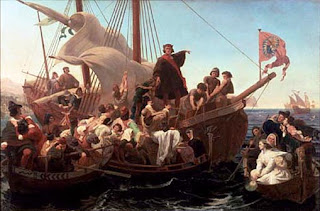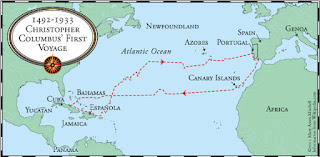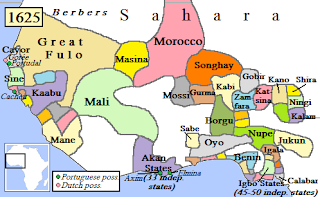the second voyage of Christopher Columbus: a taste in slavery
some days ago we posted about this great captain that soar on the great atlantic to find the new world, and the importance of his four voyages cannot be belittled. having promised you that we will post the four voyages in succession, so here is the second and more larger voyage than the first. enjoy!
christopher columbus docked from his first voyage in march 1493; and according to him the
 |
| the santa maria |
Christopher Columbus returned from his first voyage in March, 1493, having discovered the New World...although he didn’t know it. He still believed that he had found some uncharted islands near Japan or China, and that further exploration was needed. His first voyage had been a bit of a fiasco, as he had lost one of the three ships entrusted to him and he did not bring back much in the way of gold or other valuable items.
the Second Voyage:
unlike the first voyage, the second voyage was to be a large scale colonization and exploration project.He did, however, have a handful of bedraggled natives he had taken on the island of Hispaniola, and he was able to convince the Spanish crown to finance a second voyage of discovery and colonization.
Columbus was given 17 ships and over 11000 men, and European domesticated animals such as pigs, horses and cattle. Columbus’ orders were to expand the settlement on Hispaniola, convert the natives to Christianity, establish a trading post and continue his explorations in search of China or Japan. The fleet set sail on October 13th, 1493 and made excellent time, first sighting land on November 3rd.
the first landfall
The island first sighted was named Dominica by Columbus, a name it retains to this day. Columbus and some of his men visited the island, but it was inhabited by fierce Caribs and they did not stay very long. Moving on, they discovered and explored a number of small islands, including Guadalupe, Montserrat, Redondo, Antigua and several others in the Leeward Islands and Lesser Antilles chains.
Columbus had wrecked one of his three ships the year before during his first voyage. He had been forced to leave 39 of his men behind on Hispaniola, in a small settlement named La Navidad. Upon returning to the island, Columbus discovered that the men he had left had angered the native population by raping local women.
The natives had attacked the settlement, slaughtering the Europeans to the last man. Columbus, consulting his native chieftain ally Guacanagarí, laid the blame on Caonabo, a rival chief. Columbus and his men attacked, routing Caonabo and taking many of his people as slaves.
Isabella:
Columbus founded the town of Isabella on the northern coast of Hispaniola, and spent the next five months or so getting the settlement established and exploring the island. Building a town in a steamy land with inadequate provisions is hard work, and many of the men sickened and died. It reached the point where a group of settlers, led by Bernal de Pisa, attempted to capture and make off with several ships and go back to Spain: Columbus learned of the revolt and punished the plotters. The settlement of Isabella remained but never thrived: it was abandoned in 1496 in favor of a new site, now Santo Domingo.
Jamaica and Cuba :
Columbus left the settlement of Isabella in the hands of his brother Diego in April, setting out to explore the region further. He reached Cuba (which he had discovered on his first voyage) on April 30 and explored it for several days before moving onto Jamaica on May 5. He spent the next few weeks exploring the treacherous shoals around Cuba and searching in vain for the mainland. Discouraged, he returned to Isabella on August 20, 1494.
Columbus had been appointed governor and Viceroy of the new lands by the Spanish crown, and for the next year and a half, he attempted to do his job. Unfortunately, Columbus was a good ship’s captain but a lousy administrator, and those colonists that still survived grew to hate him. The gold they had been promised never materialized and Columbus kept most of what little wealth was found for himself. Supplies began running out, and in March of 1496 Columbus returned to Spain to ask for more resources to keep the struggling colony alive.
the return and slavery:
Columbus brought back many native slaves with him, most of who came from the Carib
culture, fierce cannibals who fought any and all European attempts to conquer them. Columbus, who had once again promised gold and trade routes, did not want to return to Spain empty-handed. Queen Isabella, appalled, decreed that the New World natives were subjects of the Spanish crown and therefore could not be enslaved, although the practice continued. Most of Columbus’ slaves were freed and ordered returned to the New World.
As supplies brought from Spain dwindled, Columbus decided to return to Spain to ask for more help in establishing the colony. So he fitted out two ships, one for himself and one for Aguado, placing in them two hundred dissatisfied colonists, a captive Indian chief (who died on the voyage), and thirty Indian prisoners, and set sail for Spain on 10 March, 1496, leaving his brother Bartholomew at Isabella as temporary governor. Columbus reached Cadiz 11 June, 1496
culture, fierce cannibals who fought any and all European attempts to conquer them. Columbus, who had once again promised gold and trade routes, did not want to return to Spain empty-handed. Queen Isabella, appalled, decreed that the New World natives were subjects of the Spanish crown and therefore could not be enslaved, although the practice continued. Most of Columbus’ slaves were freed and ordered returned to the New World.
As supplies brought from Spain dwindled, Columbus decided to return to Spain to ask for more help in establishing the colony. So he fitted out two ships, one for himself and one for Aguado, placing in them two hundred dissatisfied colonists, a captive Indian chief (who died on the voyage), and thirty Indian prisoners, and set sail for Spain on 10 March, 1496, leaving his brother Bartholomew at Isabella as temporary governor. Columbus reached Cadiz 11 June, 1496
relevance of the Second Voyage:
Columbus’ second voyage marked the start of colonialism in the New World, the social
importance of which cannot be overstated. By establishing a permanent foothold, Spain took the first steps towards their mighty empire of the centuries that followed, an empire that was built with New World gold and silver.
importance of which cannot be overstated. By establishing a permanent foothold, Spain took the first steps towards their mighty empire of the centuries that followed, an empire that was built with New World gold and silver.
When Columbus brought back slaves to Spain, he also caused the question of slavery in the New World to be aired openly, and Queen Isabella decided that her new subjects could not be enslaved. Although the conquest and colonization of the New World turned out to be devastating for the New World natives, one can only guess how much worse it might have been had Isabella allowed slavery in her new lands.
Many of those who sailed with Columbus on his second voyage went on to play very important roles in the history of the New World. These first colonists had a great amount of influence and power over the course of the next few decades of history in their part of the world.
posted by: t_rez
posted by: t_rez







Comments
Post a Comment